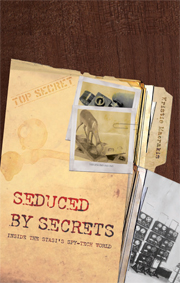Book contents
- Frontmatter
- Contents
- List of Photographs, Charts, and Table
- Abbreviations and Organizations
- Preface
- Acknowledgments
- Introduction
- PART I HIGH-TECH
- PART II SPY-TECH
- 7 James Bond, Communist-Style
- 8 Communicating Secrets
- 9 Secret Writing Revealed
- 10 Eye Spy
- 11 Big Ears
- 12 Smell Science
- 13 Spy Dust
- Note on Archival Sources
- Notes
- Index
12 - Smell Science
from PART II - SPY-TECH
Published online by Cambridge University Press: 04 December 2009
- Frontmatter
- Contents
- List of Photographs, Charts, and Table
- Abbreviations and Organizations
- Preface
- Acknowledgments
- Introduction
- PART I HIGH-TECH
- PART II SPY-TECH
- 7 James Bond, Communist-Style
- 8 Communicating Secrets
- 9 Secret Writing Revealed
- 10 Eye Spy
- 11 Big Ears
- 12 Smell Science
- 13 Spy Dust
- Note on Archival Sources
- Notes
- Index
Summary
After the fall of the Berlin Wall it became one of the most iconic images of Stasi perversity: rows of shelves stacked with jam jars stuffed with yellow dust cloths. The media frequently scanned their cameras past these stuffed jam jars when they aired shows on the Stasi to display the seemingly bizarre method used by the secret police to keep track of dissidents – by vacuum packing their smell in an airtight container. Like other Stasi techniques, smell science has a history rooted in criminalistics and the police, and, like the other methods, secrecy was paramount.
During the chaotic days of rage after the fall of the Berlin Wall, a myth, not grounded in the facts, developed on the topic of the jam jars. That myth began when Leipzig dissidents opened the door of a storage room at a local Stasi district office. Their eyes widened when they saw rows and rows of glass jars with yellow dust cloths in them. These dusters were used to wipe a surface or person to capture their smell. This was in December 1989. By June 1990 they found the same jars, empty, at the smell storage facility of the local police's service dog station. The explanation was that the police wanted to use the jars for other purposes. Despite the removal of the yellow smell-impregnated dust cloths, dissidents could determine that the Stasi had a “complete smell collection of the Leipzig opposition,” because the labels with names still remained.
- Type
- Chapter
- Information
- Seduced by SecretsInside the Stasi's Spy-Tech World, pp. 281 - 295Publisher: Cambridge University PressPrint publication year: 2008

